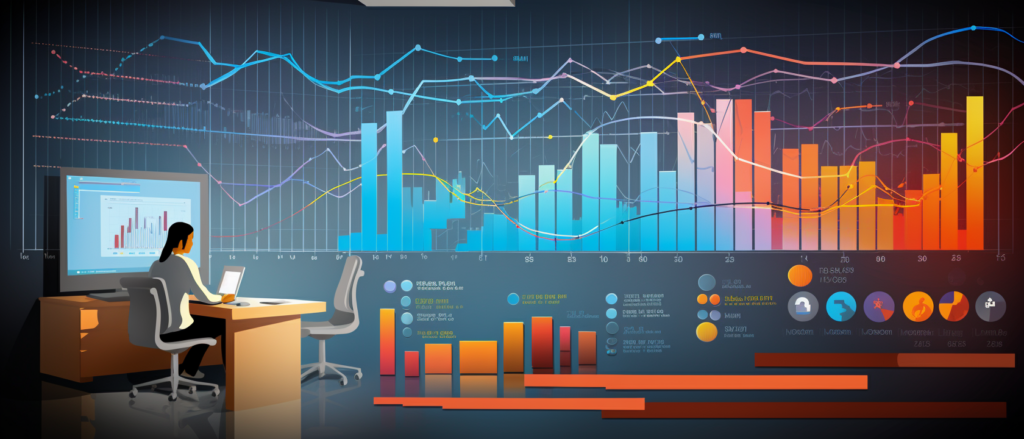Key Takeaways
✅ Data-Driven Prowess: Hone in on collecting, comprehending, and acting on consumer data and market trends to craft winning strategies that fuel business growth.
✅ Metrics That Matter: Navigate the sea of analytics by zeroing in on metrics like ROI and conversion rates to measure campaign victories and refine marketing plays.
✅ Forecast The Future: Be the maestro of predictive modeling, using historical insights and statistical savvy to anticipate trends and tailor personalized marketing drives.

Introduction
Are you leveraging the full power of your marketing data? With the essentials of Marketing Analytics, transcend guesswork and unlock strategic goldmines embedded within your brand’s data. Whether you’re a seasoned marketer or just starting out, gaining a commanding grasp of analytics is non-negotiable in today’s data-rich environment.
This article is a springboard into the ocean of marketing analytics, charting a course from the basics to the most advanced techniques. We’ll navigate through the nuances of data collection, gaze into the predictive models that forecast future trends, and learn how to communicate actionable insights that transform your marketing efforts into measurable success. Saddle up for an entrancing ride into the analytics horizon, ready to harvest actionable insights and revolutionize the way you view marketing data!
Top Statistics
| Statistic | Insight |
|---|---|
| Global Marketing Analytics Market Size: Valued at $2.63 billion in 2020 with a CAGR of 14.8% from 2021-2028. (Source: Grand View Research) | This robust growth signifies a transformational shift in the strategic importance of analytics within the marketing domain. |
| Adoption of Cloud-Based Solutions: Estimated at 75% of enterprises by 2021. (Source: Forbes) | The move to cloud computing underscores the drive for scale, efficiency, and real-time insights in marketing analytics. |
| User Demographics – Job Roles: Marketing Managers (42%), Analysts (31%), Directors (17%). (Source: HubSpot) | This distribution highlights the critical roles that strategize and engage with marketing analytics, directing business decisions and campaign effectiveness. |
Understanding Marketing Data
At the heart of effective marketing analytics lies a deep understanding of the various types of data available. This includes web analytics, which provide insights into website traffic, user behavior, and engagement. Customer data, such as purchase history, demographic information, and preferences, can also offer valuable clues about your target audience. And don't forget the wealth of information hidden within your own marketing campaigns – metrics like lead generation, conversion rates, and return on investment (ROI) can all inform your future marketing efforts.
However, it's not enough to simply collect data; you also need to ensure its quality and integrity. Robust data governance practices, such as data cleansing, standardization, and secure storage, are essential for deriving meaningful insights from your marketing analytics.
Foundational Marketing Metrics
Once you've got a handle on your data, the next step is to identify the key performance indicators (KPIs) that truly matter to your business. These might include website traffic, lead generation, conversion rates, and ROI – the metrics that directly align with your marketing objectives and overall business goals.
Defining and tracking these core metrics will give you a clear picture of your marketing performance, allowing you to identify areas of strength and opportunities for improvement. But don't stop there – dig deeper into the data to uncover the nuances and trends that can inform your decision-making.
Analyzing Marketing Performance
To extract the most valuable insights from your marketing data, you'll need to leverage a range of analytical techniques. Segmentation, for example, can help you better understand your customer base and tailor your marketing efforts accordingly. Attribution modeling, on the other hand, can shed light on the complex customer journey, revealing which touchpoints are driving the most conversions.
And let's not forget the power of predictive analytics. By using statistical models and machine learning, you can forecast future trends, anticipate customer behaviors, and make more informed decisions about your marketing strategy.
Reporting and Dashboarding
With all this data at your fingertips, it's essential to present it in a clear, actionable way. Effective data visualization through reporting and dashboarding can help you communicate your marketing performance to key stakeholders, whether that's the C-suite, your marketing team, or your clients.
By crafting visually appealing and insightful reports, you can ensure that your data-driven insights are not only understood but also used to drive meaningful change within your organization.
Leveraging Analytics for Decision Making
Ultimately, the true power of marketing analytics lies in its ability to inform and guide your marketing decisions. By using data to optimize your campaigns, you can improve their efficiency and effectiveness, maximizing your return on investment.
But it's not just about the numbers – the insights you uncover through your analytics can also help you align your marketing strategy with your broader business objectives, ensuring that your efforts are contributing to the overall success of your organization.
Inspirational Quotes
1. “Marketing is not the art of finding clever ways to dispose of what you make. It is the art of creating genuine customer value.” – Philip Kotler
Philip Kotler’s renowned perspective on marketing serves as a powerful reminder to brands and e-commerce ventures alike. At its core, e-commerce must focus on crafting valued experiences and products that resonate with the consumer’s deepest needs and aspirations. Data may direct us to what those needs could be, but it is the human touch—the careful consideration of how we fulfill those needs—that truly defines our success.
2. “Data is the new oil.” – Clive Humby
In this digital renaissance, where e-commerce is the canvas, data is indeed your most precious resource. However, data’s true potential is unlocked not just by possession but by its meticulous cultivation. Understand this, innovative entrepreneurs: Data is not just about numbers; it’s a narrative waiting to be interpreted. And those who master this art will most certainly lead the frontier of e-commerce innovation.
3. “Big data will spell the death of customer segmentation and force the marketer to understand each customer as an individual within 18 months or risk being left in the dust. – Virginia M. Rometty
Virginia Rometty’s proclamation is a call to action for all e-commerce marketers. The use of big data elevates the playing field, making obsolete the one-size-fits-all approach. In the dynamic world of e-commerce, personalized experiences reign supreme. Retailers must harness the power of analytics not merely as a tool but as a philosophy, a relentless pursuit of understanding the customer as a singular universe, rife with their own preferences, dreams, and needs.
AI Marketing Engineers Recommendation
Recommendation 1: Integrate Comprehensive Data Modeling: Dive into the myriad of data available to e-commerce businesses by embracing comprehensive data modeling. By using advanced predictive models, businesses can accurately forecast sales trends, customer behavior, and inventory needs. For instance, employing AI algorithms on large datasets shows a significant uplift in targeted campaign effectiveness—on average, businesses see a 21% increase in marketing ROI, according to McKinsey. Utilize these models to optimize marketing spend and personalize customer outreach strategies.
Recommendation 2: Leverage Behavioral Analytics for Enhanced Customer Journeys: Successful e-commerce strategies today hinge on understanding the customer’s digital body language. By tapping into behavioral analytics, companies gain insights into how customers interact with their online platforms. Spot patterns and predict future behaviors by looking at clicks, navigation paths, and engagement time. From Adobe’s Digital Economy Index, online consumers have shown a 20% increase in mobile shopping since 2019. Tailoring the user experience for mobile users based on behavior can boost conversions and reinforce customer loyalty.
Recommendation 3: Adopt Marketing Attribution Tools for Clear ROI Assessment: Attribution modeling is a critical element underpinning the Fundamentals of Marketing Analytics. Employ marketing attribution tools to track the performance of various channels in your marketing mix. With Google Analytics reporting that multi-channel funnels can account for up to 16% of transactions, it’s crucial to understand how each touchpoint contributes to conversions. Tools like Google Analytics, HubSpot, and Kissmetrics facilitate a thorough analysis of which channels deliver the best ROI—informing more effective resource allocation and strategic planning.
Conclusion
In the intricate tapestry of today’s e-commerce landscape, Marketing Analytics stands out as an indispensable thread, interwoven throughout every successful strategy. Reflecting on our comprehensive journey from data collection to actionable insights, it is evident that mastering the Fundamentals of Marketing Analytics is more than a necessity—it’s a transformative force in driving business success.
By methodically organizing and interpreting data, we unlock the historical narratives through descriptive analytics, empowering businesses with the ability to measure and understand past performances solidly. Moreover, predictive analytics provides a telescope to glimpse into the future, harnessing the power of models and algorithms, and transforming mere forecasts into a canvas of opportunity. To complete the analytics continuum, prescriptive analytics emerges as the strategic maestro, suggesting concrete decisions that optimize marketing efforts and maximize ROI.
Visualization and communication act as the bridge, connecting the analytical minds with stakeholder interests, ensuring that insights gleaned lead to informed decision-making processes. They serve not just as a function of clarity, but as a vital conduit that translates complexity into actionable and persuasive narratives. As we cast a glance toward the horizon, emergent trends and innovations in marketing analytics beckon. Continuous learning and adaptation are not options but imperatives for those who seek to navigate the dynamic currents of e-commerce.
In harnessing the power of marketing analytics, let us be intrepid, grounded in the knowledge that data is our ally and analytics, our guide. Embrace these tenets, for therein lies the keystone to unlocking growth and achieving a robust competitive edge. Revel in the empowerment that comes with knowledge, and charge forward with the confidence that your marketing strategy is not only heard but is resonating deeply in the marketplace of tomorrow.
FAQs
Question 1: What is marketing analytics?
Answer: Marketing analytics refers to the process of collecting, analyzing, and interpreting data related to marketing efforts to make informed decisions, optimize strategies, measure performance, and drive business growth.
Question 2: Why is marketing analytics important?
Answer: Marketing analytics helps companies understand customer behavior, identify trends, evaluate campaign effectiveness, improve ROI (Return On Investment), and stay ahead in today’s competitive landscape by making data-driven decisions.
Question 3: What are some common tools used in marketing analytics?
Answer: Popular marketing analytics tools include Google Analytics, Adobe Analytics, HubSpot, Tableau, Mixpanel, Heap, and Kissmetrics, among others. These platforms help track website traffic, user engagement, conversion rates, and other essential metrics.
Question 4: How can I use marketing analytics to improve my digital marketing strategy?
Answer: By using marketing analytics, you can gain insights into your audience demographics, preferences, and behaviors. This information allows you to personalize messaging, refine targeting, optimize content, and allocate resources effectively across various channels like social media, email, search engines, and more.
Question 5: How do I choose which metrics to focus on in marketing analytics?
Answer: Focus on metrics that align with your business goals and objectives. Common metrics include click-through rate (CTR), cost per acquisition (CPA), return on ad spend (ROAS), customer lifetime value (CLV), conversion rate, bounce rate, and time on site. Choose the ones that best reflect your company’s priorities.
Question 6: Can marketing analytics be applied offline too?
Answer: Yes, marketing analytics can be applied to both online and offline marketing activities. For example, tracking sales from print advertisements or measuring footfall at physical stores can provide valuable insights.
Question 7: How often should I analyze my marketing data?
Answer: Monitoring and analyzing marketing data should be an ongoing process. However, the frequency of analysis may vary based on the nature of your business, campaign duration, and the urgency of decisions. Regularly scheduled reports and real-time monitoring can help you stay on top of your marketing efforts.
Question 8: What is the role of AI and machine learning in marketing analytics?
Answer: AI and machine learning can enhance marketing analytics by automating data processing, identifying patterns and trends, making predictions, and optimizing campaigns in real-time. These technologies can help marketers make more informed decisions, improve personalization, and increase efficiency.
Question 9: How can I ensure the data I’m collecting is accurate and reliable?
Answer: To ensure accurate and reliable data, follow best practices such as using consistent tracking methods, regularly auditing data sources, implementing data quality checks, and cleaning and validating data before analysis.
Question 10: What are some common challenges in marketing analytics and how can I overcome them?
Answer: Common challenges include data overload, data silos, lack of resources, and difficulty in interpreting data. To overcome these challenges, focus on setting clear objectives, investing in the right tools, establishing data governance, and building a data-driven culture within your organization.
Academic References
- Winston, W. (2015). Marketing Analytics: Data-Driven Techniques with Microsoft Excel. Hoboken, NJ: Wiley. This foundational text introduces fundamental marketing analytics concepts using Microsoft Excel, focusing on practical applications such as customer segmentation and optimization, supplemented by real-world case studies.
- Venkatesan, R., Farris, P. W., & Wilcox, R. T. (2018). Fundamentals of Marketing Analytics: A Decision-Making Approach. Cham, Switzerland: Springer. This comprehensive textbook explores a structured approach to marketing analytics, emphasizing the role of informed decision-making and covering diverse techniques from descriptive to prescriptive analytics.
- Kardes, F. R., Cronley, M. L., & Cline, T. W. (Eds.). (2018). Handbook of Research Methods in Consumer Psychology. Cambridge, UK: Cambridge University Press. This rich anthology discusses a variety of quantitative research methodologies in consumer psychology, with detailed chapters on advanced statistical techniques that have pivotal applications in marketing analytics.
- Kohli, A. K., & Sridhar, S. (2018). Marketing Analytics: A Practitioner’s Guide to Marketing Analytics and Research Methods. Hoboken, NJ: Wiley. This guide provides an extensive look at key marketing analytics topics, stressing the significance of integrating both qualitative and quantitative data to deeply comprehend consumer behavior and market trends.
- Winston, W. (2020). Marketing Analytics: Data-Driven Techniques with Excel, R, and Tableau. Hoboken, NJ: Wiley. In this updated work, Wayne Winston elaborates on the crucial role of data visualization in marketing insights, showcasing how to utilize Excel, R, and Tableau to achieve this effectively.













